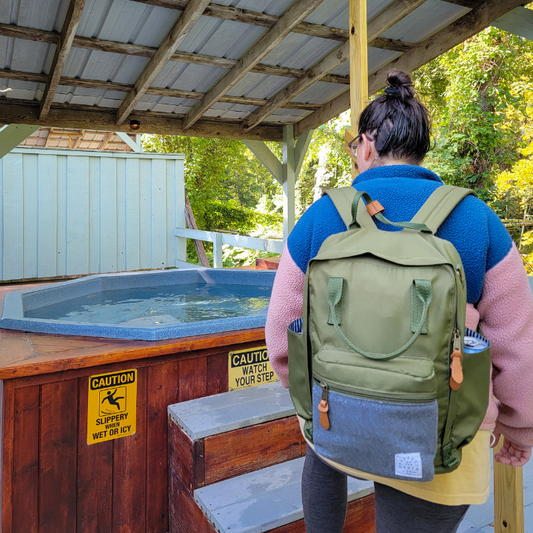Whether you’re a new mom, an experienced mom, or anxiously awaiting the arrival of your first little one, there are many new things you’ll embark on during your first year of parenthood with each baby.
From the first belly kicks and labor and delivery to diaper changes and tummy time, the learning curve for parents seems to be very similar to that of our growing babies, even if you’ve gone through the first year with another child.
That same learning curve is true when it comes to one of motherhood’s biggest feats: breastfeeding.
From mastering the perfect latch to ensuring your baby (and you!) are fed well, this natural way to nourish your baby can feel overwhelming at first, but once you get the hang of it, we promise it gets easier.
The truth is that no matter how you decide to clothe, feed, or care for your baby, the first year of parenting, especially as a first-time mother, is filled with ups and downs and a whole lot to learn.
The good news is that with the right people by your side and non-judgmental tips in toe, you will be able to master this thing called motherhood firsthand; we just know it.
At POTN, we are here to help ease some of the anxiety that can come with mastering a new challenge, which is why we wanted to give you the best tips and tricks in our diaper bag when breastfeeding your baby.
Let’s explore some of our tried and true tips and get you the answers to some frequently asked questions.

10 Tips & Tricks For Breastfeeding Your Newborn Baby
First-time moms and experienced moms alike can struggle with breastfeeding. The truth is, every baby and every woman’s body is different. If you’re hoping to nourish your baby through breastfeeding, we think preparation is key to achieving the best results for you and your baby.
Here are our top 10 tips and tricks for breastfeeding your baby for the newborn stage and beyond.

1. Be Prepared By Attending Breastfeeding Classes
It is always a good rule of thumb to learn about some of the things you’ll tackle as a mother while you’re still pregnant. One of the best ways to better understand breastfeeding is by attending breastfeeding classes for expectant mothers.
Research has shown that pregnant women who attend breastfeeding classes feel less overwhelmed when they begin breastfeeding and are more knowledgeable about the entire process, leading to a higher breastfeeding success rate than mothers who don’t prepare ahead of time.
Most community centers, hospitals, and midwifery clinics offer breastfeeding classes. Check your local area or ask your OBGYN for more information on locations and availability.

2. Begin Breastfeeding at Birth
Newborns are ready to nurse within the first few hours following birth. So even if you don’t produce a lot of breast milk initially, starting the process right from birth will help you increase your supply sooner.
The first feeds help you bond with your baby and become more comfortable with breastfeeding in general. They also provide your baby with colostrum, a thick yellow fluid filled with antibodies and proteins to help support your baby’s first moments outside of your womb.
Other benefits of breastfeeding from birth include:
- Skin-to-skin contact, which helps your baby stabilize their heart rate, body temperature, blood sugar, and breathing.
- Oxytocin release, which helps you feel more confident in your nurturing as you bond with your baby for the first time.

3. Get Comfortable + Try Different Positions While Nursing
Comfort is vital when it comes to breastfeeding for both you and your baby. Find a spot in your home and places that you frequent that feels comfortable for you to sit for extended periods.
Try out different breastfeeding positions and consider using a nursing pillow to help stabilize your baby for easier latching and more all-around comfort.
Some worthwhile positions to try include:
- The cradle position– The most common of all positions, the cradle hold involves holding your baby in both arms as if you’re cradling them. Their head should rest on the bent elbow of your arm near the breast you plan to breastfeed them on. Their body should be turned inward with their head slightly tilted up to your breast.
- The cross-cradle positions– Similar to the cradle hold, this position differs based on the arm in which you are holding the baby. In this position, the baby’s body will turn inward to you while you support their head with your hand. Their bottom should rest in the bend of your elbow. Your free arm can add support for your breast from underneath. This is a great position for newborns who struggle to latch properly.
- The football hold– just as it sounds, this position involves tucking your baby under one arm as if you were cradling a football. The baby should be positioned on one side at hip level with their head tilted up toward your breast. You will cradle the back of their body with your arm. This is an excellent position for feeding multiples, those with larger breasts and those who have had a c-section.
- The laid back positions- Find a comfortable, laid back position on a bed, recliner, or sofa. Use pillows to support your back, neck, and arms as needed. Once laid back, place your baby on your stomach with their head tilted toward your breast. This is a great position for newborns, preemies, and multiples and also considered one of the most comfortable positions by many breastfeeding moms.
- Side-lying positions– This position differs from others as it does not involve sitting up. While lying on one side, place your baby next to your body with your breast lifted and within reach for them to properly latch. Side-lying is a more restful option for mother and baby and is great to use at nighttime feedings. If you choose to, always be sure to remain awake and lay your baby back into their crib once the feeding is complete.

4. Maintain A Healthy & Balanced Diet
Maintaining a healthy diet while breastfeeding is just as important as it was during pregnancy. In order for you to properly nourish your baby, you must nourish yourself.
As parents, especially new moms, we can often find ourselves getting lost in all the tasks that our baby needs us to follow through with and forgetting about ourselves. The best thing you can do for yourself is properly nourish your body. It will help stabilize your energy levels and mood, increase your milk production, and help you heal sooner.
Not to mention, a healthy diet for mom equals a healthy diet for baby.
Some key tips to stay on top of your nutrition while breastfeeding include:
- Taking a multivitamin, prenatal vitamin, or other supplements as recommended by your healthcare provider.
- Eating well-balanced meals that include fruits, vegetables, dairy, lean meats and proteins, and complex carbohydrates.
- Eating enough food. Remember that breastfeeding alone burns around 500 calories daily, so you must supplement this loss with nutrients.
- Avoid sugary drinks and alcohol.
- Limit your caffeine intake to under 200mg a day.
- Avoid smoking.
- Limit your consumption of high mercury seafood, such as tuna, swordfish, and mackerel.
- Drink plenty of water- at least 100oz per day.
- Don’t wait long periods between meals. Supplement with healthy snacks.

5. Get The Right Nursing Supplies
With all the baby care products on the market, the options can feel overwhelming regarding nursing supplies. Don’t feel like you need to snag one of everything to be a successful breastfeeding mom.
Instead, focus on the goal of providing an easier and more comfortable experience for you and your baby with the products you choose.
Must-have breastfeeding items include:
- A breastfeeding pillow– to help with extra support while cradling your baby during a feeding.
- A few well-fitting nursing bras– to give your breasts ample support with the fluctuation in breast size due to milk production. Nursing bras are also the perfect way to easily feed your baby without having to remove layers of clothing. Consider buying a size bigger than your normal bra size to accommodate larger post-baby breasts.
- Breast pads– Your breasts may leak milk before or after feedings or due to engorgement. Reusable breast pads that slip into your bra help to avoid any unexpected leakage accidents on your clothing.
- Backpack diaper bag- For new moms that are on the go, a backpack diaper bag is a perfect accessory for carrying your nursing and changing supplies.
Other nice-to-have items include:
- A rocker-glider to nurse your baby comfortably in.
- A breast pump, glass baby bottles, breast milk storage bags, and an insulated mini travel cooler to keep your milk fresh while on the go.
- An ottoman or footstool to help prop your legs up for comfort and easier feeds.

6. Feed From Both Breasts Equally
You may quickly realize that you or your baby has a favorite side to nurse on. Although the goal of breastfeeding is to ensure your baby is getting ample breast milk and growing as they should, equal opportunity for both breasts is needed for the best breastfeeding results.
Switch sides halfway through a feeding session or go back and forth each session. If your baby is adamant about breastfeeding on one side, consider pumping the other breast to keep your supply up. You can do this while nursing or directly before or after feedings.

7. Keep Engorgement at Bay
Breast engorgement is a common condition that occurs most often in the early stages of breastfeeding. Symptoms include swelling, tightness, and an overall size increase in your breasts.
Engorgement occurs when your milk ducts are overfilled with breast milk causing your blood vessels to swell.
The best way to avoid engorgement is to breastfeed your baby every time they show signs of being hungry.
If your breasts become engorged, you can:
- Apply warm compresses to the affected breast before and during feeding to help the milk flow out more easily and reduce swelling.
- Apply cold compresses before or after a feeding to relieve pain and swelling.
- Express your breast milk manually using your hand or a breast pump.
- Gently massage your breasts to help with pain and milk buildup.
- Change breastfeeding positions to express milk from different areas and ducts in your breasts.

8. Follow Your Baby’s Hunger Cues
As a first-time mom, it can be hard to gauge when a baby is hungry outside of their loud wails for some nourishment. However, breastfed babies often provide us moms with hunger cues to be on the lookout for.
Although a planned feeding schedule is a nice way to keep everyone on track, every baby is different, and most don’t stick solely to a plan, especially as newborns.
Some of the most common hunger cues include:
- Putting their hands to their lips
- Sucking on their fingers
- Flexing their arms with their hands in a fist
- Whimpering
- Making sucking motions and noises with their mouth
- Moving their arms and hands in what feels like irritation
- Nuzzling your breasts or skin

9. Properly Care for Your Nipples
Sore nipples are common for newly breastfeeding moms. However, after the first few weeks, your nipples should become less tender, and it should not hurt to breastfeed or pump.
To lessen nipple discomfort:
- Ensure a proper latch during each feeding.
- Change up the breastfeeding position and side.
- Allow breastmilk to dry on your nipples after feeding to soothe any tenderness and dry areas.
- Use breast pads between feedings and switch them out after they’ve become soiled.
- When bathing, avoid using soap on your nipples. Instead, rinse them gently with warm water.
- Apply over-the-counter nipple ointment to tender and cracked nipples
If your nipple pain and tenderness worsen or don’t go away, or if you experience cracked or bleeding nipples, we encourage you to speak with your doctor or lactation consultant for a more thorough diagnosis and treatment plan.

10. Don’t Be Afraid to Ask for Help
The bottom line is that breastfeeding can be challenging for new and experienced mothers alike. Each child comes with a new set of challenges we must overcome as parents, breastfeeding included.
If you’ve tried various tips and tricks to get breastfeeding down pat and are still have trouble with latching, nipple pain, feeding times, or any other nuance, we encourage you to seek the help of lactation experts and doctors who can work with you one-on-one to ensure the best outcomes for you and your baby.
If you’re struggling with breastfeeding or any other aspect of your parenting journey, never be afraid to ask for help. At one point or another, every parent has leaned on someone else for guidance; it’s nothing to be ashamed of.

Breastfeeding FAQs
Now that we’ve divulged our tried-and-true breastfeeding tips, we wanted to touch upon some important and frequently asked questions.
We hope this curated FAQs list helps answer some of your biggest questions and makes your breastfeeding experience a little easier for everyone involved.
What Are The Benefits of Breastfeeding?
We’ve probably all heard the phrase “breast is best,” and although we believe that fed is best, we do know that there are several benefits to breastfeeding your baby.
Here are some of the most substantial benefits of breastfeeding:
- As your baby grows, breast milk adapts to your child's nutritional and health needs. Essentially, it is the most nutrient-dense option for your baby as it is tailored specifically for them.
- Breast milk shares antibodies from the mother with the baby.
- You can feed your baby anytime, anywhere.
- Breastfeeding has been proven to reduce the risk of breast and ovarian cancers, type II diabetes, and high blood pressure in mothers.
- A reduction in the risk of various illnesses and conditions in your infant, including middle ear infections, colds, flu, gut issues, respiratory infections, and sudden infant death syndrome.
- Breastmilk promotes healthy weight in babies.
What is the Let-Down Reflex?
The let-down reflex is your body’s response to your baby sucking on your breast. In short, it’s what makes breastmilk flow and resupply.
Upon latching, tiny nerves in the breasts are activated that cause the release of oxytocin and prolactin, which help produce milk and push it out through the breasts and nipples.
Some women feel the let-down reflex and equate it to a tingling sensation in the breasts, while others do not feel it.
What Foods Help Produce Breast Milk?
Although a healthy, balanced diet is the most important factor in the quality and quantity of your breast milk, various foods can increase milk production.
If you’re hoping to up your milk supply, try adding the following to your diet:
- Whole grains
- Dark green leafy vegetables
- Fennel
- Barley
- Oats
- Papaya
- Garlic
- Chickpeas
- Sesame seeds
- Almonds
- Flaxseed
- Ginger root
- Nursing teas
How Do I Know if My Baby is Getting Enough Milk?
Because we can’t measure out breastmilk to ensure ample consumption, it can be hard to tell if your baby is getting enough milk.
Look for these signs the next time you feed to ensure your baby is getting enough milk:
- Your baby starts feeding with a few quick sucks followed by longer sucks and swallows with occasional pauses.
- You can see and hear your baby swallowing.
- Your baby's cheeks stay rounded when they suck.
- Your baby is calm throughout the feeding.
- Your baby comes off the breast on its own when they’re done.
- Their mouth looks moist after feeding.
- Your baby appears satisfied afterward.
- Your breasts are emptier and softer after feeding sessions.
Other tell-tale signs of proper nourishment include:
- Steady weight gains at doctor visits
- A regular poop schedule
- Wet diapers every few hours
How Long Does Breastfeeding Last?
A typical breastfeeding session lasts 10 to 20 minutes but can be as short as five minutes and as long as an hour depending on various factors, including:
- Baby’s age
- Alertness
- Breast milk flow speed
- Latching
- Breast milk supply
Will Using a Breast Pump Affect My Baby’s Normal Feedings?
The short answer is no. Using a breast pump won’t affect your baby’s regular feedings.
In fact, the more you feed and pump, the more robust your supply will be. If you are overproducing or experiencing engorgement, pumping is recommended for relief.
Can I Use a Pacifier or Bottle for My Breastfeeding Baby?
It depends.
If your goal is to solely breastfeed, introducing a pacifier or bottle too early can cause latching issues that make breastfeeding more difficult. Before introducing a pacifier, it is best to wait until your baby has fully acclimated to breastfeeding. Most health experts recommend waiting until your baby is 1-2 months old before pacifier use.
If you plan to pump and provide your baby with breastmilk using a bottle, you can immediately begin using pacifiers and bottles.
It is important to note that the American Academy of Pediatrics (AAP) recommends giving your baby a pacifier during sleep because some studies have shown that they may help protect babies from sudden infant death syndrome (SIDS).
However, they agree that waiting until breastfeeding is established is a feasible option for babies who exclusively breastfeed.
Is It Okay to Supplement Breastfeeding with Formula?
Yes, supplementing is a great and safe option for women who cannot produce enough breast milk on their own.
Although standard formula is a fine choice, you may also want to consider utilizing donor breast milk or supplementing with organic vegan formula options to avoid any complications that may arise from a dairy-based alternative.
Before you begin to supplement, it is always important to speak with your child’s pediatrician to ensure you start with the proper amount of milk and the appropriate formula for your baby’s age and unique health and nutrition needs.
How Can I Breastfeed in Public?
No rule or law says you should or shouldn’t breastfeed your baby in public. It’s an entirely personal decision you can plan for ahead of time or do in the spur of the moment.
The truth is, as much as we want to plan out our entire day, there are going to be plenty of times when our baby is ready to eat no matter where we are, so it’s always a good idea to have items on hand to help you feel more comfortable with breastfeeding your newborn, well, anywhere.
Some of the best tips for breastfeeding in public include:
- Wear loose-fitting clothing, especially for your top.
- Wear a nursing bra whenever you go out.
- Use breast pads to help avoid leakage before or after feedings.
- Bring along a blanket, sling, or breastfeeding cover to place over your shoulder and your baby while feeding.
- Find a spot that is comfortable for you and your baby.
- Use a designated feeding area in stores, restaurants, or other public places that may have them.
And remember, no matter where you choose to breastfeed your baby, you should never feel embarrassed or worried about it. You are literally giving your baby the fuel it needs to live a healthy, nourished life, which is something to be proud of.
When Should I Stop Breastfeeding?
Healthcare professionals recommend breastfeeding your baby for at least the first six months of life. After that, many mothers continue breastfeeding until at least a year or longer, depending on their child’s unique needs and breastfeeding goals.
There is no set time to begin or end breastfeeding. Always do what is best for you and your family alongside the advice of your doctors.
Can I Become Pregnant While Breastfeeding?
The short answer is yes, you can become pregnant while breastfeeding.
In some instances, such as with exclusive breastfeeding, which involves nursing at least every four hours during the daytime and at least every six hours at night, for the first six months after birth and before the return of your menstrual cycle, it can act as a form of birth control and prevent pregnancy. This is referred to as the lactational amenorrhea method (LAM). You must ensure that all criteria is met for this option to be effective.
For most women, though, while breastfeeding offers some protection against ovulation, there is still a risk of becoming pregnant.
What If I am Unsuccessful or Cannot Breastfeed?
Let’s be honest– breastfeeding is hard. The breasts are complex parts of the body that don’t always work as expected, especially following the birth of a baby, which is a major feat in itself.
It is important to understand that various personal factors come into play when it comes to breastfeeding. From medical conditions to lifestyle changes, breastfeeding isn’t a viable option for thousands of women.
The best news is that there are still great ways to nourish your baby. If you cannot breastfeed, choose not to, or are unsuccessful, it’s completely okay and absolutely normal. Don’t ever feel less-than for not being a breastfeeding mama. You are worthy and are doing what is best for your baby.

Wrapping Up Our Top 10 Breastfeeding Tips Every First-Time Mom Should Know
Whether you’re a first-time mom or have reservations about successful breastfeeding techniques while adding another baby to your home, these breastfeeding tips and tricks will help make the experience smoother. After reading this, we hope you feel more confident and prepared to breastfeed your little one.
If you’re a first-time mom or expecting a baby soon, we’ve put together a few guides to help you on your journey:
Remember, every baby is different, so don’t be discouraged if things don’t go perfectly according to plan. Instead, just relax, take things slow, and enjoy this special time with your new little one.
And finally, don’t forget to stock up on all your nursing supplies – like our new XO Elkin diaper bag backpack – before your baby arrives. If you’re planning on traveling with your newborn, you may need something bigger like our XO Alden Weekender backpack duffel bag. Both are sustainably manufactured using 100% recycled materials, making them perfect for eco-friendly parents.
We wish you all the best during these exciting early months of motherhood!
And remember, no matter where your baby’s feeding journey takes you, a fed baby is best, no matter what.




